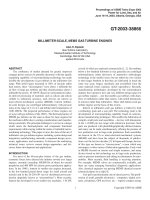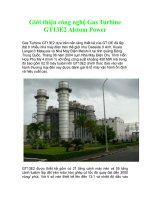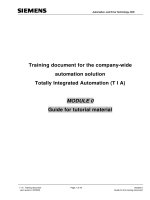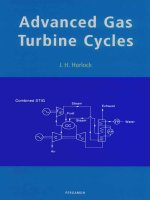Week1 GE gas turbine training document
Bạn đang xem bản rút gọn của tài liệu. Xem và tải ngay bản đầy đủ của tài liệu tại đây (1.7 MB, 21 trang )
Welcome to GT Operation,
Performance, and
Overview
Laura Boes
9 May, 2013
GT Basics - Agenda
GT Components
Actuator, Sensors
Other Power Plant
Components/Configurations
Operating Philosophies / Regimes
Thermodynamics
GE products/ Nomenclature
2
2013 Controls Training: GT Basics
5/9/2013
GT components – basic Physics
Principle of Conservation of Mass:
mass in = mass out
(steady
state)
Principle of Conservation of Energy:
energy in = energy out
(steady
state)
Plant converts
Power
energy
may
be
transformed
from
Chemical
one to
form
to another
Thermal
Fue
l
Generator
to Mechanical
to Electrical Energy
3
2013 Controls Training: GT Basics
5/9/2013
GT components - basics
Note: s denotes entropy
Compression increases Pressure and Temp, decreases
volume
Combustion increases Temp, Volume & Entropy
Turbine section harnesses high-pressure hot gases to
turn shaft to produce power and low-pressure, cooled
air is exhausted
4
2013 Controls Training: GT Basics
5/9/2013
Gas Turbine Sensors/Actuators
FPG2
(psig)
Legend:
IGV– critical
effectors
TTXM – critical
(F) sensors
(Units)
(F)
PM1
AFPAP
(inHg)
AFPCS
(inH2O)
PM2
PM3
CTIM
Comb
(F)
~
DWATT
(MW)
7FA+e DLN 2.6
shown
SRV Quat
ATID
C
TNH
(%)
CPD
IGV
(psig)
TTXM
CTD
IBH
Sensor Signals:
ATID – Ambient Temperature
AFPAP – Ambient Pressure
AFPCS – Inlet Pressure Drop
CTIM – Compressor Inlet Temperature
DWATT – Generator Output
T
Other Critical Control Parameters:
CA_CRT – combustion reference temperature
TNHCOR – inlet temp-corrected speed
CPR – compressor pressure ratio
(F)
(F)
FPG2 – P2 Fuel Pressure
TNH – Shaft Speed as % of Design Point
CPD – Compressor Discharge Pressure
CTD – Compressor Discharge Temperature
TTXM – Exhaust Gas Temperature
5
GE Title or job number
9/21/20
Power Plant Configurations
(as you will hear them in GE Engineering)
Simple Cycle – GT exhaust direct to
atmosphere
Combined Cycle – GT exhaust
passes through HRSG (Heat
Recovery Steam Generator) to
transfer heat to Steam system
Multi-Shaft – GT with only a
Generator attached to its centerline
Single Shaft – GT and ST on same
shaft with a single generator
6
2013 Controls Training: GT Basics
5/9/2013
Operating Philosophies
95% of our customers produce power for
the transmission grid
• Cyclic plants start and stop most days
• Baseloaded plants start 2-50 times/year
• Peakers run when demand (price) is so high they are profitable
(or mandatory)
Emissions Compliance is mandatory for
most
• NOx and CO emissions are commonly permitted pollutants
• Each unit has a range where emissions will comply with their
permit
7
2013 Controls Training: GT Basics
5/9/2013
Operating Philosophies - Start to
Base
Start sequence – Purge, Fire/Warmup,
Accel
Sequence of interactions with no operator intervention
Loaded operation – Synch through Base
Load
• GT speed and Gen phase must be matched to grid parameters
– While synchronized, the GT is ‘slaved’ to grid speed, cannot
control
• GT will stabilize at “Spinning Reserve” ~=7% of full power
•
Thatcher to cover load
Operator can dictate desired load and GT will go there (within
control in-depth in next
limits)
class
8
2013 Controls Training: GT Basics
5/9/2013
Typical Gas Turbine Startup Mission
PG7241FA Gas Turbine Typical Startup Characteristics
( @ ISO Conditions; NG Fuel )
130
Starting Cycle
1300
Loading Cycle
120
1200
110
1100
Notes:
%TNH = Turbine Speed (100% = 3600 rpm
%Wx = Exhaust Flow (100% = Design Flow)
Tx
= Exhaust Temperature
100
90
1000
H
900
80
800
70
700
Tx (F)
% Wx
60
600
50
500
40
400
IGV (Deg)
%%Loa
Load
IGV (Deg)
30
300
d
20
% Wx
200
** For Reference Only
10
100
0
0
0
2
4
6
8
10
*1) Purge time will vary based on Exhaust System Characteractics
*2) DLN
Prestar
t
Tx (F)
TNH(%), Load(%), Wx(%), IGV (Deg)
%
TNH
%TN
Purg
e
Fire &
Warmu
p
12
14
16
18
20
22
24
26
28
Time (minutes)
Accelerati
on
Sync & Temp
Match
Loading
9
GE Title or job number
9/21/20
GT components - basics
Note: s denotes entropy
Compression increases Pressure and Temp, decreases
volume
Combustion increases Temp, Volume & Entropy
Turbine section harnesses high-pressure hot gases to
turn shaft to produce power and low-pressure, cooled
air is exhausted
10
2013 Controls Training: GT Basics
5/9/2013
Compressor
We use compressor maps at
base load IGV position
Wair,cor = f (CPR, Ncor)
comp = f (CPR, Ncor)
PR(OLL) = f (IGV, Ncor)
• Corrected parameters simplify map
• Map adjusted for IGV closing
• Compressor Extractions
provide cooling
flow to turbine
- CPR = Pout / Pin
- Ncor = f (N, Tin)
- Wair,cor = f (Wair, Tin, Pin)
SURGE LINE
OPERATING LIMIT LINE
BASE LOAD LINE
NO LOAD LINE
11
2013 Controls Training: GT Basics
5/9/2013
Combustor
GTP models the following features of the
combustor:
Fuel is mixed with Air
Mixture is burned accounting for combustor
efficiency
Pressure loss through combustor
Emissions model (includes crude estimate of
modes)
Cooling of TP with compressor discharge air
F/A
Mixing
Premix
12
2013 Controls Training: GT Basics
5/9/2013
Turbine Section
We model the following features of the turbine:
Accounts for individual stages
Tracks expansion / cooling of hot compressed
gas
Computes the work extracted
Each stage has a unique efficiency and PR
maps,
similar to the
compressor maps
13th stg.
Comp.
bleed
9th stg.
Comp.
bleed
CD
Compressor
Bleed
13
2013 Controls Training: GT Basics
5/9/2013
Firing Temperature (Tfire)
Defined as gas temperature at point in cycle where initiation of
turbine work begins (N1 Trailing Edge / B1 Leading Edge)
Highest temperature point in cycle for thermal performance, but
NOT the hottest point in cycle
Key parameter related to gas turbine performance. Emissions
relies on T 3.9
Nozzle/Wheelspace Cooling Air
(Chargeable)
Firing Plane
B
N 1
1
Combustor &
T
Combustor
3.9
N
2
B
2
N
3
B
3
Turbine
Exit Flow
N1 Cooling Air
(Non-Chargeable)
Bucket/Wheelspace Cooling Air
(Chargeable)
14
2013 Controls Training: GT Basics
5/9/2013
Gas Turbine Performance (GTP)
GTP is a 1-D Aero-Thermal
Mathematical
Model of the Entire GT Cycle
– Physics based models: Thermodynamics,
Aerodynamics, Compressible Flow, Heat Transfer
– Steady state, near-nominal speed model only
– Built & Maintained By Advanced Technology
Operations (ATO), Integrated Performance (IP)
team
– GTP contains many Cycle Decks that represent the
many different GT models
– Used as a design and validation tool
– />
15
2013 Controls Training: GT Basics
5/9/2013
ARES vs GTP
ARES (Adaptive Real-Time Engine
Simulation) is a Model of a Specific GT
– Runs onboard the controller of all MBC machines
– Stripped the ‘multiple options’ ability of GTP to
model only 1 set of hardware. Therefore it can run
every frame (40ms)
– Built By Advanced Technology Operations (ATO),
Integrated Performance (IP) team, published by
GEIP with Toolbox (ST)
– Inputs: sensed conditions, fuel properties, tuners.
– Outputs: 50 predetermined parameters (T fire,
T3.9, etc), knobs (measures of error)
16
Basics
– Critical enabler of our ETS & AT products 2013
byControls Training: GT5/9/2013
Gas Turbine Cycle Deck
New Cycle Deck
Nomenclature
How to decipher New Cycle Deck Nomenclature:
7FA.03-05A-0509A
7 – Frame size (9, 7, 6)
FA – Class (FA, FB)
.03 – Rating / Technology revision (.01, .02, .03, .04, .
05, …)
-05 – Hardware configuration major option
A – Hardware configuration minor option
-0509 – Cycle deck release date in MMYY format
A – Cycle deck option (not required)
17
2013 Controls Training: GT Basics
5/9/2013
Gas Turbine Cycle Deck
Old Cycle Deck
Nomenclature
How to decipher Old Cycle Deck Nomenclature:
PG9371-04B-0806A
PG – Application; PG = Power Generation,
M = Mechanical Drive,
IG = IGCC
9 – Frame size (9, 7, 6)
37 – Horsepower rating, # x 10,000 = HP
1 – Number of drive shafts
-04 – Hardware configuration major option
B – Hardware configuration minor option
-0806 – Cycle deck release date in MMYY format
A – Cycle deck option (not required)
18
2013 Controls Training: GT Basics
5/9/2013
Gas Turbine Products: F-class
19
2013 Controls Training: GT Basics
5/9/2013
Gas Turbine Products: E-Class
20
2013 Controls Training: GT Basics
5/9/2013
Questions?









